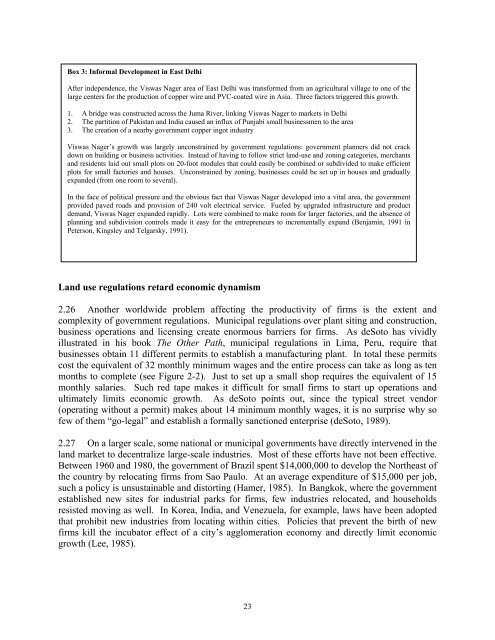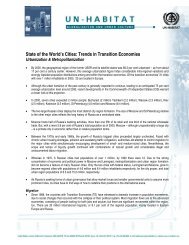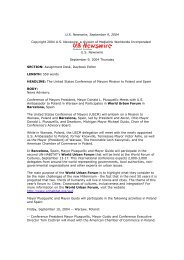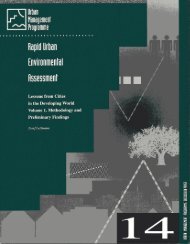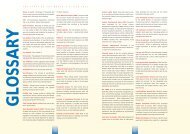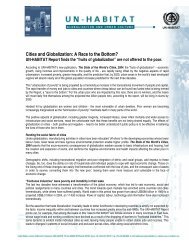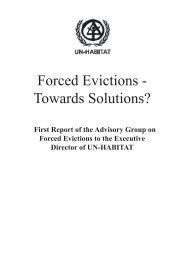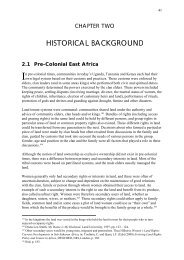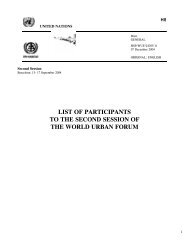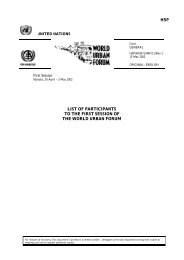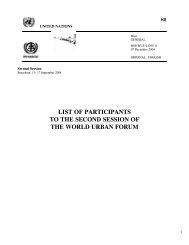a framework for reforming urban land policies in ... - UN-HABITAT
a framework for reforming urban land policies in ... - UN-HABITAT
a framework for reforming urban land policies in ... - UN-HABITAT
Create successful ePaper yourself
Turn your PDF publications into a flip-book with our unique Google optimized e-Paper software.
Box 3: In<strong>for</strong>mal Development <strong>in</strong> East Delhi<br />
After <strong>in</strong>dependence, the Viswas Nager area of East Delhi was trans<strong>for</strong>med from an agricultural village to one of the<br />
large centers <strong>for</strong> the production of copper wire and PVC-coated wire <strong>in</strong> Asia. Three factors triggered this growth.<br />
1. A bridge was constructed across the Juma River, l<strong>in</strong>k<strong>in</strong>g Viswas Nager to markets <strong>in</strong> Delhi<br />
2. The partition of Pakistan and India caused an <strong>in</strong>flux of Punjabi small bus<strong>in</strong>essmen to the area<br />
3. The creation of a nearby government copper <strong>in</strong>got <strong>in</strong>dustry<br />
Viswas Nager’s growth was largely unconstra<strong>in</strong>ed by government regulations: government planners did not crack<br />
down on build<strong>in</strong>g or bus<strong>in</strong>ess activities. Instead of hav<strong>in</strong>g to follow strict <strong>land</strong>-use and zon<strong>in</strong>g categories, merchants<br />
and residents laid out small plots on 20-foot modules that could easily be comb<strong>in</strong>ed or subdivided to make efficient<br />
plots <strong>for</strong> small factories and houses. Unconstra<strong>in</strong>ed by zon<strong>in</strong>g, bus<strong>in</strong>esses could be set up <strong>in</strong> houses and gradually<br />
expanded (from one room to several).<br />
In the face of political pressure and the obvious fact that Viswas Nager developed <strong>in</strong>to a vital area, the government<br />
provided paved roads and provision of 240 volt electrical service. Fueled by upgraded <strong>in</strong>frastructure and product<br />
demand, Viswas Nager expanded rapidly. Lots were comb<strong>in</strong>ed to make room <strong>for</strong> larger factories, and the absence of<br />
plann<strong>in</strong>g and subdivision controls made it easy <strong>for</strong> the entrepreneurs to <strong>in</strong>crementally expand (Benjam<strong>in</strong>, 1991 <strong>in</strong><br />
Peterson, K<strong>in</strong>gsley and Telgarsky, 1991).<br />
Land use regulations retard economic dynamism<br />
2.26 Another worldwide problem affect<strong>in</strong>g the productivity of firms is the extent and<br />
complexity of government regulations. Municipal regulations over plant sit<strong>in</strong>g and construction,<br />
bus<strong>in</strong>ess operations and licens<strong>in</strong>g create enormous barriers <strong>for</strong> firms. As deSoto has vividly<br />
illustrated <strong>in</strong> his book The Other Path, municipal regulations <strong>in</strong> Lima, Peru, require that<br />
bus<strong>in</strong>esses obta<strong>in</strong> 11 different permits to establish a manufactur<strong>in</strong>g plant. In total these permits<br />
cost the equivalent of 32 monthly m<strong>in</strong>imum wages and the entire process can take as long as ten<br />
months to complete (see Figure 2-2). Just to set up a small shop requires the equivalent of 15<br />
monthly salaries. Such red tape makes it difficult <strong>for</strong> small firms to start up operations and<br />
ultimately limits economic growth. As deSoto po<strong>in</strong>ts out, s<strong>in</strong>ce the typical street vendor<br />
(operat<strong>in</strong>g without a permit) makes about 14 m<strong>in</strong>imum monthly wages, it is no surprise why so<br />
few of them “go-legal” and establish a <strong>for</strong>mally sanctioned enterprise (deSoto, 1989).<br />
2.27 On a larger scale, some national or municipal governments have directly <strong>in</strong>tervened <strong>in</strong> the<br />
<strong>land</strong> market to decentralize large-scale <strong>in</strong>dustries. Most of these ef<strong>for</strong>ts have not been effective.<br />
Between 1960 and 1980, the government of Brazil spent $14,000,000 to develop the Northeast of<br />
the country by relocat<strong>in</strong>g firms from Sao Paulo. At an average expenditure of $15,000 per job,<br />
such a policy is unsusta<strong>in</strong>able and distort<strong>in</strong>g (Hamer, 1985). In Bangkok, where the government<br />
established new sites <strong>for</strong> <strong>in</strong>dustrial parks <strong>for</strong> firms, few <strong>in</strong>dustries relocated, and households<br />
resisted mov<strong>in</strong>g as well. In Korea, India, and Venezuela, <strong>for</strong> example, laws have been adopted<br />
that prohibit new <strong>in</strong>dustries from locat<strong>in</strong>g with<strong>in</strong> cities. Policies that prevent the birth of new<br />
firms kill the <strong>in</strong>cubator effect of a city’s agglomeration economy and directly limit economic<br />
growth (Lee, 1985).<br />
23


